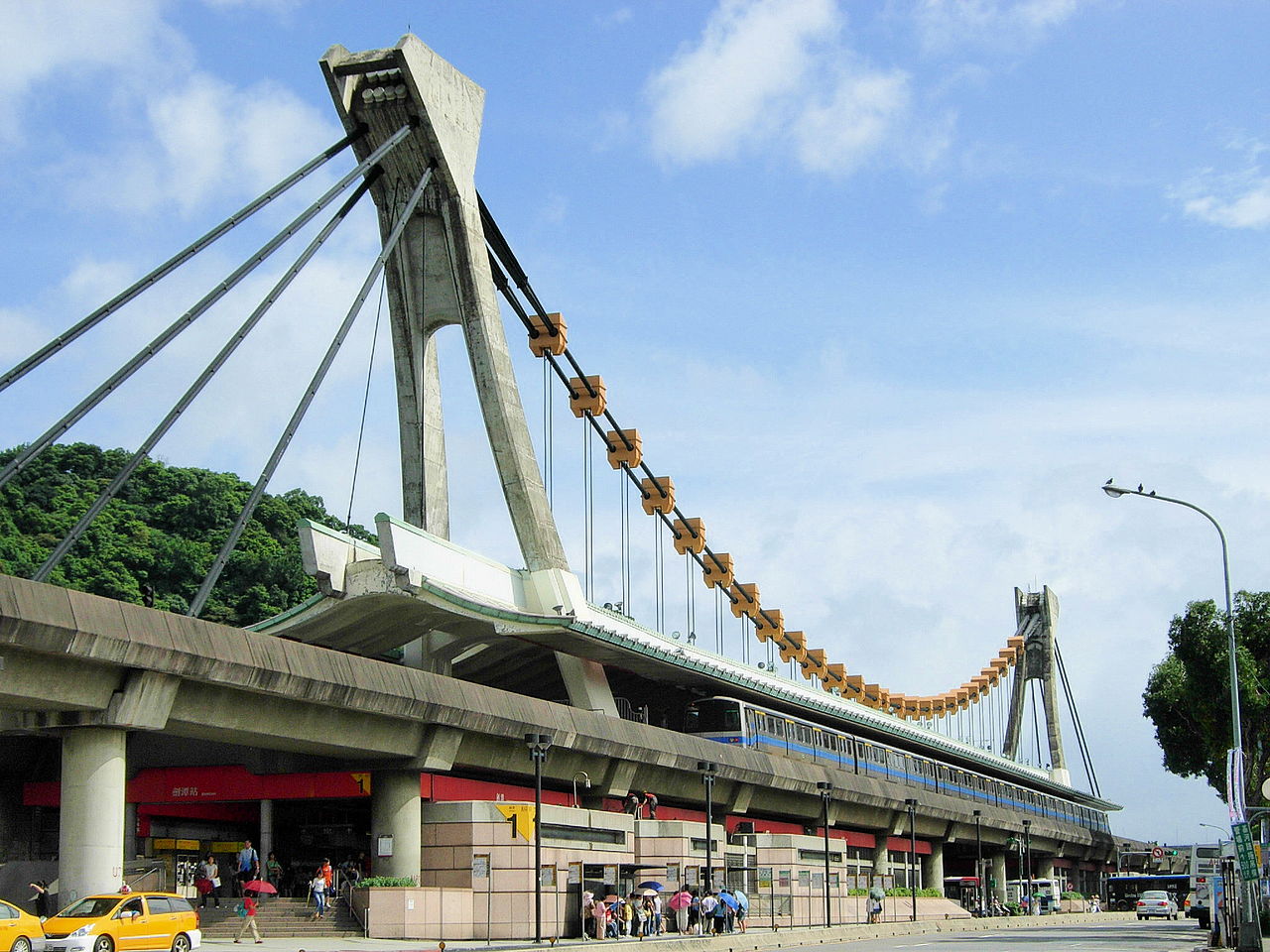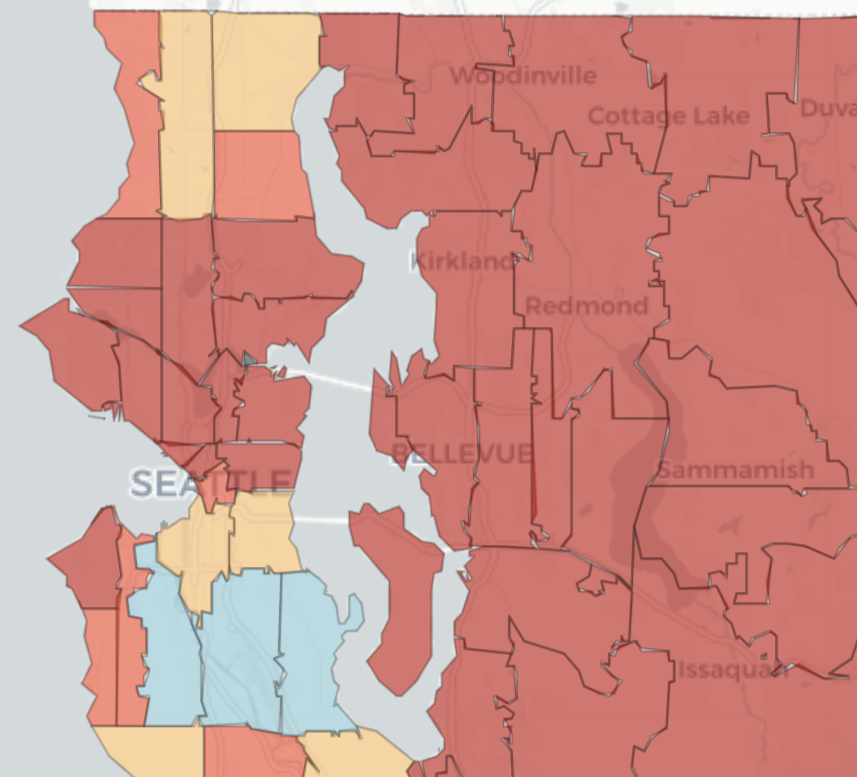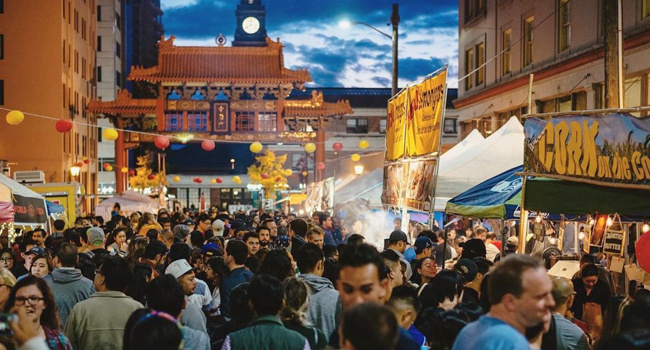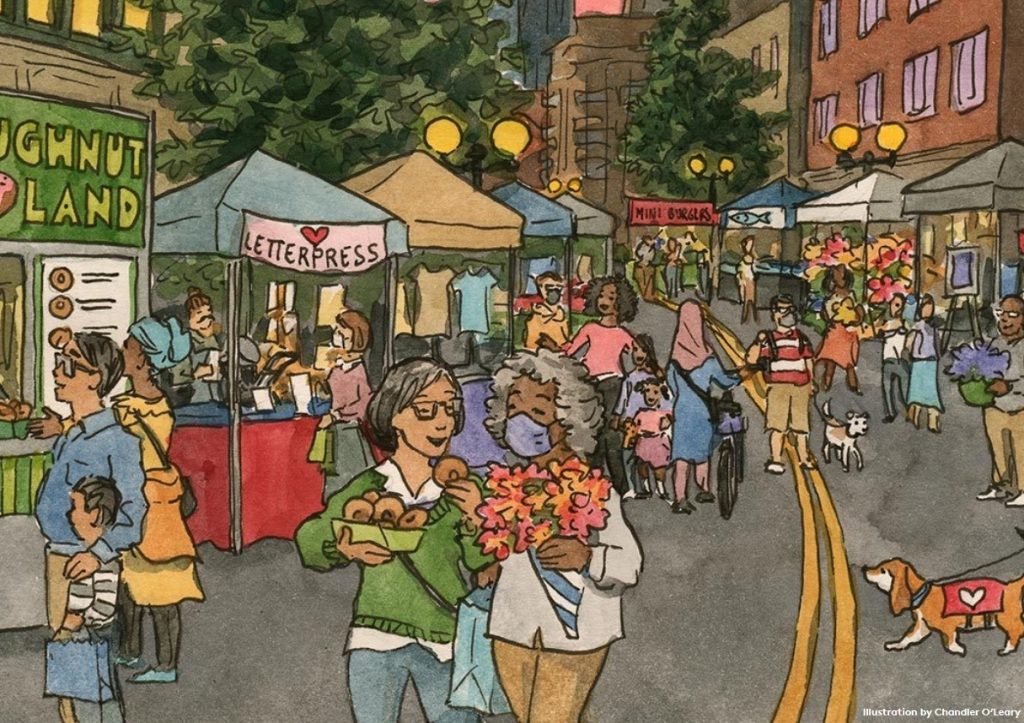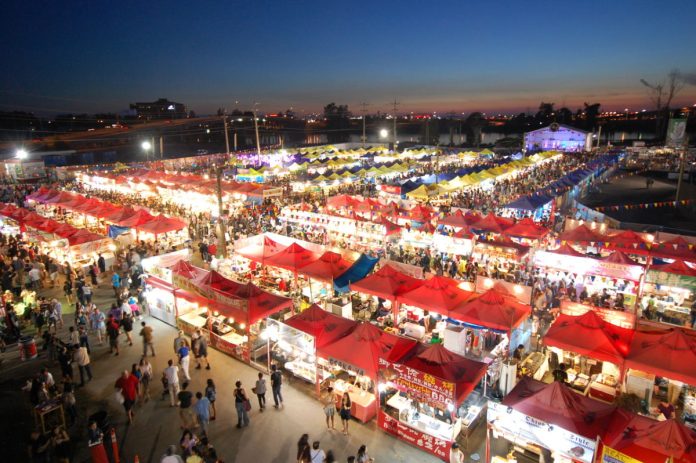
With over a year of Stay Healthy Streets and Café Streets, Seattleites have become accustomed and even approving of the pedestrianization and expanded use of our streets. But Seattle can go farther to create even more vibrant pedestrian environments, and regular night markets should be one route for street use expansion. Popular in East Asia and Southeast Asia, night markets are often street markets that open or remain open in the later hours of the day. These markets aren’t limited to streets; they inhabit a mix of parks, public squares, parking lots, cavernous indoor spaces, and anywhere else people can gather, shop, walk, and dine. Nighttime street markets would be an intuitive evolution of the city’s usage of our streets and public spaces, as they would be similar to farmers markets with hours that stretch into the night, and with a stronger emphasis on eateries.
The Downtown Seattle Association (DSA) is currently considering a Seattle Night Market as a part of their Revitalize Downtown Seattle initiative. Referencing Seattle’s close ties with Asia, the DSA conceptualizes a late-night bazaar with food stalls, live music, and shopping. Their concept conjures up North America’s largest night market in close by Richmond. Held right outside of Vancouver, British Columbia, the Richmond Night Market takes place three days a week for a few months a year, attracting more than 30,000 visitors per evening and hosting more than 400 booths during its pre-pandemic heights.
When I think about night markets, I recall my time in Taiwan. There, night markets are tightly intertwined into the culture, serving locals and tourists. Shilin Night Market (士林夜市) has always had the most lasting impression on me with street vendors spilling out from an indoor market into surrounding streets, effectively incorporating many surrounding businesses into the night market. With an elaborate subway station and transit center nearby, the night market made for a highly accessible pedestrian experience.
Seattle even already has a handful of annual night market events. The University of Washington’s Taiwanese Student Association (TSA) has held the UW Night Market annually at UW’s Red Square in the past few pre-pandemic years, and over 9,000 people attended in 2018. The Chinatown-International District Night Market (CID Night Market), organized by the Chinatown International District Business Improvement Area (CIDBIA), is held annually on S King Street by the light rail station. Northwest Marketplaces (NWM), which runs the Fremont Sunday Market and South Lake Union Saturday Market, organizes an annual night market event as well. Farmers markets like Pike Place, the Fremont Sunday Market, and the U District Farmers Market all could fall also under the broad umbrella of night markets with their various vendors, and usage of street space. They’d just need their hours extended later into the night.
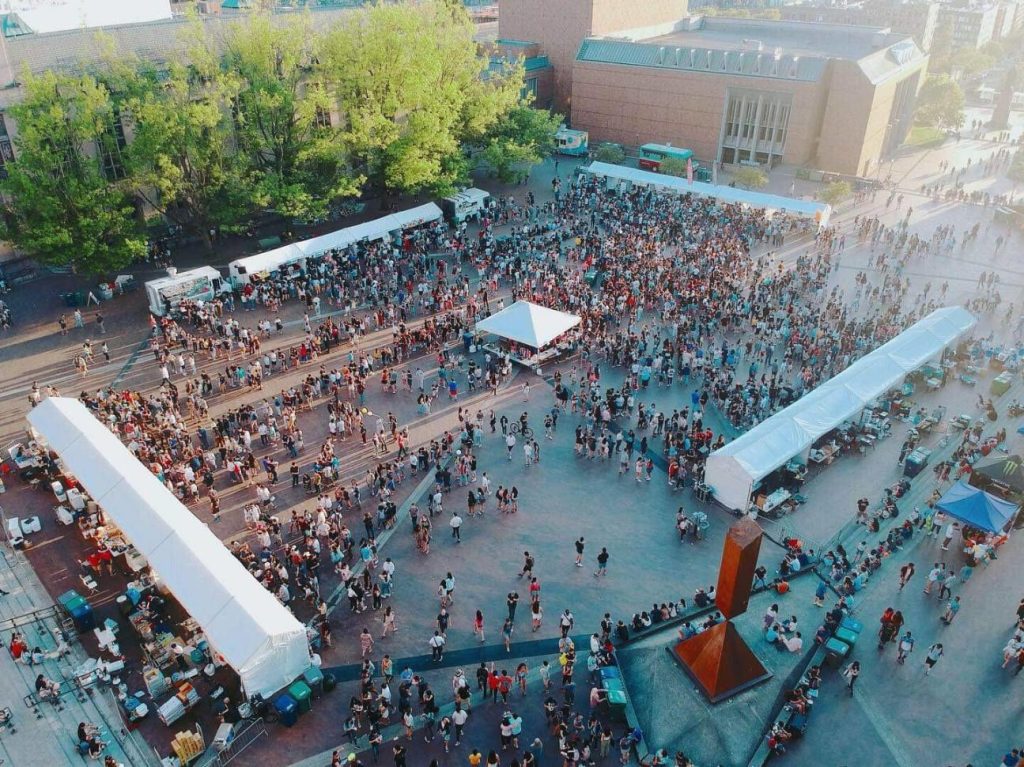
Making the case for frequent night markets
As we emerge from the pandemic and recession with tools to make more pedestrian-friendly places, we should take advantage of the opportunity to encourage highly active pedestrian environments like night markets. A night market would thrive if it could take advantage of Seattle’s pandemic-era street programs. A Stay Healthy Street in a commercial area could provide a great venue for a night market, while the Café Street program could provide market infrastructure. There, direction should be taken from the cooperation of the Ballard Farmers Market and Ballard Avenue businesses with pergolas that double as farmers market booths.
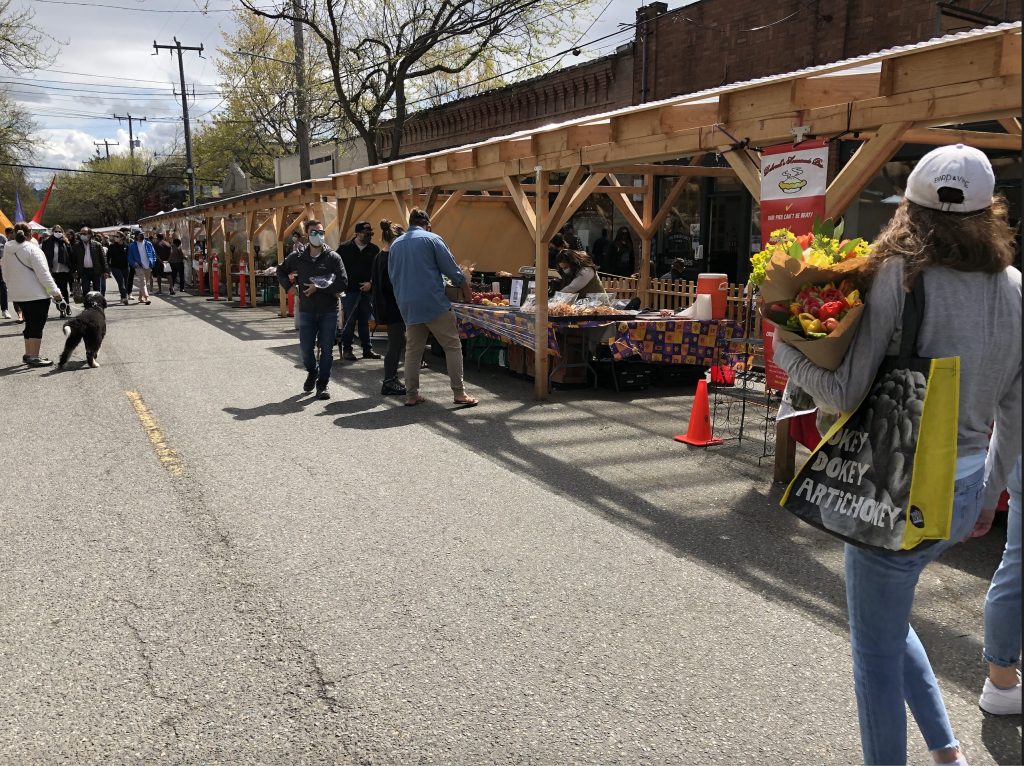
These markets would also be an opportunity to generate economic activity. A study by the New York City Department of Transportation found that more pedestrian-safe environments are typically a boon to businesses. Pairing that with an extension of active hours in a place like Downtown Seattle could open up our commercial core to populations with less access to an area that shutters around at 5:00pm. Perhaps these extended active hours would encourage the retail core to stay open for longer, further boosting commercial and pedestrian activity.
There’s also the potential to attract tourists from inside and outside the region. DSA’s interest in night markets seems to primarily arise from the potential to further activate Downtown Seattle with an additional and consistent wave of visitors. With the Richmond Night Market’s success in mind, it’s easy to draw similarities between the Seattle metro area and Vancouver metro area to justify establishing more frequent night markets in Seattle. Moreover, attracting the success of the Richmond Night Market seems achievable and beatable with an established Seattle Night Market based in the Seattle Metro’s larger population.
Night markets could also cater to our region’s rapidly growing Asian population. In Seattle, the number of Asian residents grew by nearly 50% with an increase of over 41,000 from 2010 and 2020. Other cities in King County saw increases between 80% to 200% in the same decade. Night markets may help bring a level of familiarity and comfort for these new residents and potential business owners. These markets would also be an opportunity for other communities in our region to start lower barrier of entry businesses.
Organizing and siting a night market in Seattle
While expounding on the benefits of a night market is easy, organizing and siting such a regular event would be an endeavor. There would need to be an organization willing to support vendors and interact with stakeholders. Anything that approaches the magnitude of the Richmond Night Market at its height would have major impacts on their sited area. This is likely further complicated by the operating hours. Of course, there’d also be permitting, logistics, security, and transportation issues to resolve.
If the DSA were to pursue a night market to revitalize downtown Seattle, they could approach the Chinatown-International District Business Improvement Area to expand the CID Night Market from an annual event to a seasonal or more frequent occurrence. Its typical location on South King Street is highly compelling with its location in Seattle’s historic Asian neighborhood. Transportation access would be provided with the neighboring CID light rail station, which will be connected to the Eastside’s burgeoning Asian population in 2023. Expanding the size of the night market would be tricky, as there is a residential population around the existing CID site, but there are a number of parking lots and plenty of street space to expand into.
To get a regular Seattle night market right, vendor support will be critical, as a night market would ideally bring in new businesses and extend existing businesses into a model unfamiliar to them. While a night market/farmers market booth model might be cheaper to conduct compared to a physical restaurant, business owners will still have to navigate food business permitting and booth limitations. There are different levels of food handling permits, Certified Booth Operator requirements and trainings, and fees to sort out.
But if successful, these markets should proliferate. Maybe there’s capacity and willingness in existing organizers to add more night market organization to their repertoires. Many of our existing outdoor markets like the U District Farmers Market and Fremont Sunday Market could make for fantastic night markets if their hours were extended, footprint increased, and perhaps frequency increased.
We certainly have some capacity to hold these events. Our farmers markets are mostly organized by nonprofits like Neighborhood Farmers Markets and Seattle Farmers Market Association. Northwest Marketplace does their annual night market already. Plus, there are community/student organizations that also have some kind of capacity to run night market-esque events include the CIDBIA, TSA, and VietQ, which recently held a Queer & Trans Night Market in White Center.
Today, night markets are a novel occurrence in Seattle, but there’s a strong case to be made that they should be a fixture of our pedestrianized spaces. Farmers markets and other outdoor markets have long proven that these kinds of street-occupying markets would be a hit in our region. Plus, there’s institutional interest from the DSA, which is currently collecting feedback on revitalization concepts like a Seattle Night Market — go give them some positive feedback if you’d like to see a frequently held night market in Seattle.
Shaun Kuo is a junior editor at The Urbanist and a recent graduate from the UW Tacoma Master of Arts in Community Planning. He is a urban planner at the Puget Sound Regional Council and a Seattle native that has lived in Wallingford, Northgate, and Lake Forest Park. He enjoys exploring the city by bus and foot.


